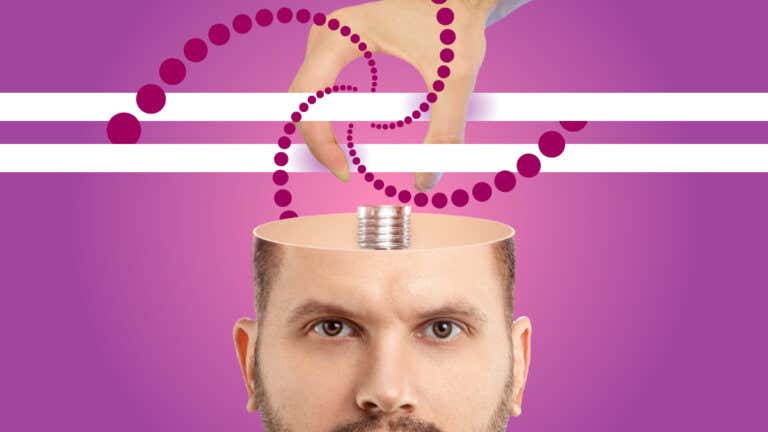There is a gestalt principle that gives meaning to the lines around us and helps organize the world. Do you want to know how our brain helps us perceive coherently? We explain it to you.
The Gestalt approach, an introduction to the study of perceptual psychology and psychophysics, stipulates a series of laws to determine how our brain interprets what we see in order to work with the environment. Among these principles, the Gestalt Law of Continuity stands out, which we will analyze in this article.
What we see as a world of defined shapes and features is actually an array of lights. The irony is that This interpretation mechanism that the brain has is also capable of deceiving the sense of sight. Want to know more? Well, keep reading.
Gestalt: Arranging and defining stimuli
Gestalt psychology, whose founding father was Max Wertheimer, takes its name from a word meaning in German form or figure. The movement that emerged in the 1920s took this name for its school, as part of its proposal for Arranging and determining how the mind perceives external stimuli In a comprehensive and simplified manner.
Because when considering the stimuli we perceive, it becomes difficult to think about categorizing them all individually. Imagine giving each tree a different name instead of sorting them by species. Although no plant is like another, it is not possible to store them in memory without a process of abstraction.
So, Gestalt studied how the mind transforms the world into something intelligible to our mind. Through the laws, they tried to explain the process that takes place in the brain to arrange, classify and simplify the elements that we perceive through the senses. One of these laws is the law of continuity.
What is the Gestalt law of continuity?
Also known as The principle of continuityThis law determines that A shape is better perceived the more continuous it is. Even when this continuity is interrupted, the brain tends to take it for granted.
This “deception” of the mind is explained by the ease it provides when focusing on certain points. If your vision is focused on a linear element, it will follow the smoothest, most consistent path.
So, Perceiving lines and contours allows us to recognize shapes in the environment in a simpler way. Even if these lines are interrupted by other elements, the brain will assume that they continue beyond the obstacle and a sense of order and coherence will be obtained.
Imagine a line made up of dots. In reality, it is nothing more than a series of points close together, but you could very likely think of it as something continuous.
How it works?
It is easy to understand the law by thinking in lines and dots, but the tricks of our perception go further. To intentionally use it in different fields (or better understand how it works) We must commit Three basic principles:
- Assembly: Elements that are close together are more likely to be viewed as part of the overall shape.
- Directivity: Each element of the set has a similar orientation so that the brain can provide them with continuity.
- similarity: If the points forming the assumed line are very different from each other, then applying continuity will be more complicated, and vice versa.
If we take the example of a constellation, we will see that the tendency to form star shapes depends on the fact that some of them are close to each other and follow similar directions.
Uses and examples of the law of gestalt continuity
After all this, you will better understand how our brain organizes information to create a more coherent view of the environment in which we live. but, Is it possible to use Gestalt laws to influence perception? The answer is in the affirmative. Take a look at these examples where the continuity principle applies:
- maps: What at first glance looks like a network of streets, makes sense when a line is drawn through them. Thus, what was previously a series of numbers becomes a path to follow.
- Advertising: In marketing, a lot is played by directing the gaze towards the item that will be highlighted. For example, if a product is placed in the middle of two lines forming
- Visual art: In photography and other graphic arts, such as painting, the Gestalt law of continuity is used to create compositions. Thus, by arranging the image elements, the overall effect of cohesion is achieved.
- graphic design: This law is a great facilitator of perception through object design. It is commonly found in web pages, applications, and other visual environments where it is intended to facilitate directing the gaze toward specific elements.
A principle that contributes to reasoning and learning
Finally, it is important to emphasize that the Gestalt law of continuity (and all other laws) is not governed solely by physical qualities such as the placement or proximity of elements. Logical and cultural learning also influences, Because the brain classifies these perceived elements and extracts concepts from them.
It is known that the way this principle works varies depending on the place in which it is taught. Therefore, when envisioning its work, we cannot forget the diversity of human minds and the transformative power of culture.
All sources mentioned have been deeply reviewed by our team to ensure their quality, reliability, validity and validity. The references contained in this article were considered reliable and of academic or scientific accuracy.
- Ciavardo, M., and Di Santo, E. M. (2020). The Breviary is one of the laws of the Gestalt.Teaching visual language: foundations for constructing an alternative proposal. Faculty of Arts, National University of La Plata. https://scholar.googleusercontent.com/scholar?q=cache:2wLLuBKFQYwJ:scholar.google.com/+law+of+continuity+de+la+Gestalt&hl=es&as_sdt=0.5&as_ylo=2014&as_yhi=2024
- Quinlan, P. T., & Wilton, R. N. (1998). Grouping by proximity or similarity? Competition between Gestalt principles in vision. Imagine, 27(4), 417-430. https://journals.sagepub.com/doi/abs/10.1068/p270417
- Koborov, S., Mshedeldze, T., & Vonessen, L. (2015). Gestalt principles in charting. in Graph Drawing and Network Visualization: 23rd International Symposium, GD 2015, Los Angeles, CA, USA, September 24-26, 2015, Revised Selected Papers 23 (558-560). Springer International Publishing. https://link.springer.com/chapter/10.1007/978-3-319-27261-0_50
- Wagemans, J. (2014). 'Historical and conceptual background: Gestalt theory, In Johan Wagemans (ed.), The Oxford Handbook of Cognitive OrganizationOxford Library of Psychology. https://academic.oup.com/edited-volume/38175/chapter-abstract/333037853?redirectedFrom=fulltext&login=false
- Wertheimer, M. (2017). Max Wertheimer and Gestalt Theory. Routledge.

“Beeraholic. Friend of animals everywhere. Evil web scholar. Zombie maven.”


